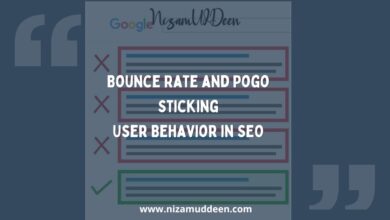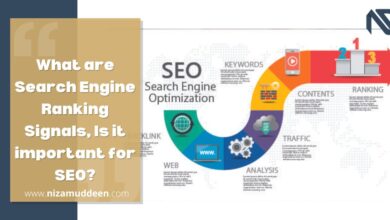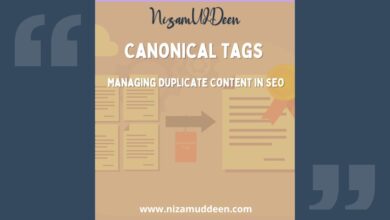Impact on SEO
Negative Effects of Broken Links on SEO
User Experience:
User experience is a critical factor in the success of any website. Broken links can significantly disrupt the user journey, leading to frustration and dissatisfaction.
Users encountering broken links may perceive the website as outdated or poorly maintained.
Frustrated visitors are more likely to leave the site, increasing the bounce rate, which is a negative signal for search engines.
Search Engine Crawling and Indexing:
Search engines use crawlers to navigate and index web pages. Broken links can impede the crawling process, affecting a site’s visibility on search engine results pages (SERPs).
Crawlers follow links to discover and index content. Broken links create dead ends, preventing crawlers from accessing certain pages.
Pages with broken links may not get indexed, leading to a loss of visibility on search engines.
Negative Effects of 404 Errors on SEO
Ever clicked on a link and ended up on a page that says “404 Not Found”? It’s like reaching a dead end in the online world.
These 404 errors not only confuse you but also have a not-so-great impact on how search engines view your website.
Search Engine Rankings:
Search engine algorithms consider the availability and relevance of web pages. Frequent 404 errors can adversely impact a site’s ranking.
Search engines interpret 404 errors as an inability to deliver the requested content, potentially leading to a downgrade in rankings.
Consistent 404 errors may signal to search engines that the website is not well-maintained, affecting its overall credibility.
User Trust and Experience:
Trust is a crucial element in retaining website visitors. 404 errors can erode user trust and negatively impact the overall user experience.
Users encountering 404 errors may question the reliability of the website, leading to a loss of trust.
A well-handled 404 page can mitigate trust issues by providing helpful information and navigation options, minimizing the negative impact on user experience.
In summary, the negative effects of broken links and 404 errors on SEO are multifaceted, impacting not only the technical aspects of search engine crawling and indexing but also user experience, trust, and ultimately, the website’s ranking on search engine results pages.
Detecting Broken Links and 404 Errors
Periodic Website Audits
Regular website audits are essential for maintaining a healthy and optimized online presence. Periodic checks for broken links and 404 errors help ensure a seamless user experience and support search engine performance.
Manual Checks:
Manual inspection involves a hands-on examination of the website’s content and links. While time-consuming, manual checks offer a detailed understanding of the site’s structure.
Reviewing each page’s content and verifying the integrity of internal and external links.
Manually clicking through links to identify any that lead to non-existent or redirected pages.
Automated Tools (e.g., SEO crawlers):
Automated tools streamline the process of identifying broken links and 404 errors, offering efficiency and scalability in website maintenance.
Utilizing specialized SEO crawlers such as Screaming Frog, Ahrefs, or SEMrush to systematically scan the entire website.
Generating reports that highlight broken links, 404 errors, and other potential issues, providing a comprehensive overview for website administrators.
Webmaster Tools
Webmaster tools provided by search engines offer valuable insights into a website’s health and performance. Google Search Console and Bing Webmaster Tools, in particular, provide features to identify and address issues related to broken links and 404 errors.
Google Search Console:
Google Search Console is a powerful tool that allows webmasters to monitor and optimize their site’s presence in Google Search. It includes features for identifying and resolving issues related to broken links and 404 errors.
Crawl reports highlight pages with crawl errors, including those with broken links or resulting in 404 errors.
The URL Inspection tool enables a closer look at specific URLs, providing information on indexing status and detected issues.
Bing Webmaster Tools:
Bing Webmaster Tools is Microsoft’s counterpart to Google Search Console, offering insights into how Bing indexes and ranks a website. It also provides tools for identifying and resolving issues like broken links and 404 errors.
The Crawl Information report provides details on crawl issues, including broken links and 404 errors.
Submitting URLs for indexing and monitoring the index status to ensure proper handling of pages.
In summary, combining manual checks with automated tools and utilizing webmaster tools from search engines empowers website administrators to effectively detect and address broken links and 404 errors, contributing to a well-maintained and SEO-friendly online presence.
Strategies for Handling Broken Links
Redirects
When encountering broken links, employing appropriate redirects is a fundamental strategy. Redirects guide users and search engines to the correct destination, preserving link equity and maintaining a seamless user experience.
301 Redirects for Permanently Moved Pages:
A 301 redirect is a permanent redirect that signals to both users and search engines that a page has been permanently moved to a new location.
Implemented when a page’s URL changes permanently.
Ensures that users and search engines are automatically directed to the new URL.
Preserves the majority of the link equity from the old URL to the new one.
302 Redirects for Temporary Changes:
A 302 redirect is a temporary redirect used when a page has temporarily moved, and the original URL is expected to return in the future.
Applied when a page is temporarily unavailable or under maintenance.
Search engines understand that the redirect is temporary and do not transfer link equity to the new URL.
Useful when planning to revert to the original URL after a specific period.
Removing or Updating Links
Beyond redirects, managing broken links involves either removing them entirely or updating them to point to valid destinations. This proactive approach ensures a clean and functional link structure.
Deleting or Replacing Broken Links:
Sometimes, broken links are better removed altogether, especially when the linked content is no longer available or relevant.
Identify and remove links that lead to permanently unavailable pages.
Replacing broken links with relevant, up-to-date alternatives maintains the integrity of the content.
Updating Internal Links after URL Changes:
When URLs change, updating internal links within the website is crucial for ensuring a seamless navigation experience for users and search engines.
Identify all instances of internal links pointing to the old URL.
Update the internal links to reflect the new URL structure.
Helps maintain a coherent site structure and avoids confusion for both users and search engines.
In summary, employing 301 and 302 redirects for permanent and temporary changes, respectively, and actively managing broken links by either removing or updating them are key strategies for maintaining a well-organized and user-friendly website, contributing to positive SEO outcomes.
Strategies for Handling 404 Errors
Custom 404 Pages
When users encounter a 404 error, a well-designed custom 404 page can turn a potential negative experience into a positive one. Custom 404 pages are user-friendly, informative, and can help retain visitors on your site.
Designing User-Friendly and Informative Pages:
Custom 404 pages should be designed to communicate effectively with users, explaining the error and providing guidance on what to do next.
Include a clear and friendly error message explaining that the requested page is not found.
Provide links to the homepage or other important sections to help users navigate to relevant content.
Consider incorporating a search bar to allow users to find what they are looking for directly.
Including Navigation Links:
Navigation links on custom 404 pages help users explore alternative content, reducing the likelihood of them leaving the site due to a dead end.
Feature prominent links to popular or important pages on the site.
Group links logically to guide users toward related or commonly sought-after content.
Encourage users to continue browsing by showcasing interesting or trending content.
Redirecting to Relevant Pages
In addition to custom 404 pages, redirecting users from a 404 error to relevant pages is an effective strategy to maintain engagement and prevent users from leaving the site prematurely.
Avoiding Blank or Generic 404 Pages:
Blank or generic 404 pages provide a poor user experience and do not offer any guidance on where users should go next.
Avoid default server-generated 404 pages that lack informative content.
Customize the 404 page to include a message, relevant links, and possibly a site search option.
Personalize the page to match the overall design and tone of the website.
Providing Suggestions or Search Options:
Offering suggestions or a search option on the 404 page empowers users to find alternative content, minimizing frustration.
Present a list of popular or recently viewed pages as suggestions.
Include a search bar that allows users to enter keywords and find relevant content.
Implement an intelligent search algorithm that can provide accurate and helpful results even with partial queries.
In summary, creating user-friendly custom 404 pages and implementing redirection strategies, such as avoiding generic 404 pages and providing suggestions or search options, contribute to a positive user experience and help retain visitors who encounter errors on your website.
Preventive Measures
Regular Content and Link Checks
Proactive maintenance is crucial for preventing broken links and 404 errors. Regularly scheduled content and link checks ensure that the website remains functional and user-friendly.
Content Maintenance Schedule:
Establishing a content maintenance schedule involves routinely reviewing and updating website content to identify and rectify potential issues.
Develop a content review schedule based on the frequency of content updates.
Regularly assess the relevance and accuracy of information on each page.
Update or remove outdated content to prevent broken links and maintain user trust.
Link Integrity Checks:
Periodic link integrity checks involve scrutinizing all internal and external links to ensure they are active and correctly pointing to their intended destinations.
Utilize automated link-checking tools to scan the website for broken links.
Check the validity of external links, ensuring they lead to reputable and functional sources.
Implement a systematic approach to fixing or removing broken links promptly.
Proper URL Structure
A well-structured URL system contributes to a website’s overall stability and usability. Adhering to consistent naming conventions and minimizing unnecessary URL changes helps prevent 404 errors.
Consistent URL Naming Conventions:
Establishing consistent URL naming conventions simplifies navigation, enhances user experience, and reduces the likelihood of broken links.
Adopt a standardized approach for naming URLs, incorporating clear and descriptive keywords.
Ensure that URLs reflect the content hierarchy and organization of the website.
Communicate naming conventions to all content creators and editors for uniformity.
Avoiding URL Changes Unless Necessary:
Minimizing unnecessary URL changes reduces the risk of introducing 404 errors and helps maintain search engine rankings.
Prioritize stability in URL structures to avoid disruptions in link integrity.
Implement redirects only when absolutely necessary, especially for high-traffic pages.
When changes are required, use proper redirects (e.g., 301) to seamlessly transition users and search engines.
In summary, incorporating preventive measures such as regular content and link checks, along with maintaining a proper URL structure, helps mitigate the risk of broken links and 404 errors. These practices contribute to a more resilient and user-friendly website, positively impacting SEO performance.
Utilizing SEO Tools
Imagine SEO tools as your website’s secret agents—kind of like friendly spies that help your online home be its best.
These tools quietly check and improve things so your website is easy to discover and enjoyable for visitors. It’s like having undercover helpers ensuring your website is always in tip-top shape.
Google Search Console
Google Search Console is a powerful suite of tools provided by Google to help webmasters monitor, optimize, and troubleshoot their website’s presence on Google Search. It offers specific features that assist in identifying and addressing crawl errors and broken links.
Monitoring Crawl Errors:
Crawl errors can hinder the indexing of a website. Google Search Console provides insights into crawl errors, including those related to broken links and 404 errors.
Access the “Coverage” report in Google Search Console to identify pages with crawl issues.
Analyze specific error types, including “Not Found” errors, which indicate 404 issues.
Address crawl errors by implementing appropriate redirects or fixing broken links.
Using URL Inspection Tool:
The URL Inspection tool in Google Search Console allows webmasters to examine how Googlebot views a specific URL, providing details on indexing and potential issues.
Enter the URL into the URL Inspection tool to check its current status in Google’s index.
Review information on crawling, indexing, and any reported issues.
Use this tool to troubleshoot and address problems associated with 404 errors or broken links.
Third-Party SEO Tools
In addition to Google Search Console, third-party SEO tools offer comprehensive features for website analysis and maintenance.
Popular tools like SEMrush, Ahrefs, and Moz include functionalities specifically designed for detecting and managing broken links.
SEMrush, Ahrefs, Moz, etc.:
Third-party SEO tools provide in-depth insights into a website’s performance and offer features dedicated to identifying issues like broken links and 404 errors.
SEMrush, for example, includes a Site Audit feature that scans websites for issues, including broken links.
Ahrefs’ Site Audit tool helps discover and address SEO-related problems, including broken links and redirects.
Moz offers a similar Site Crawl feature that helps webmasters identify and fix issues impacting site health.
Features for Broken Link Detection:
Many third-party SEO tools include specialized features for detecting and managing broken links, providing detailed reports and recommendations.
Utilize the broken link detection feature to identify broken or problematic links across the website.
Receive comprehensive reports outlining the location and severity of broken links.
Take advantage of additional functionalities, such as prioritization and recommendations for fixing broken links.
In summary, leveraging Google Search Console for insights into crawl errors and utilizing third-party SEO tools with dedicated features for broken link detection empowers webmasters to proactively manage and optimize their websites, ensuring a healthy and well-performing online presence.
Summary of the Topic
Taking care of broken links and 404 errors is like keeping a tidy house for your website:
- Understanding the Issues:
- Broken links are like paths that go nowhere, causing frustration.
- A “404 Not Found” error is like a sign saying a room (webpage) doesn’t exist.
- Importance in Simple Terms:
- Broken links and generic 404 pages frustrate visitors.
- They also impact how often people find your website through search engines.
- Proactive Strategies:
- Regularly check your website, similar to tidying up your house.
- Organize your URLs and use redirects wisely for a well-kept online space.
- Utilizing Tools for Website Health:
- Tools like Google Search Console act as a security system.
- Third-party SEO tools (like SEMrush, Ahrefs, Moz) are like having a cleaning crew for your website.
- Overall Impact:
- Regular checks and fixes create a welcoming online home.
- A well-maintained website is more trusted and visible.
By applying these simple strategies, you ensure your website remains a reliable and pleasant place for everyone. Just like a clean house, a well-maintained website is more inviting and trustworthy.



